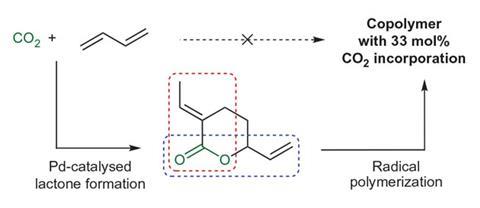
Carbon dioxide is inert, so it needs a high-energy reactant to drive reactions, limiting its use as a feedstock. Some of these processes include the industrial production of urea, salicylic acid, organic carbonates and polycarbonates. Olefins are suitable co-reagents for polymerisation with carbon dioxide because they have a high potential energy owing to their carbon–carbon double bonds. But the problem is that the reaction needs so much energy to kick-start it that it typically leads to the olefins linking with up other olefins, rather than carbon dioxide.
Now, Kyoko Nozaki and her team from the University of Tokyo, Japan, have come up with a way to surmount the thermodynamic and kinetic barriers of copolymerising carbon dioxide with an olefin. The team stumbled on a solution to this problem while investigating whether it was possible to polymerise the lactone intermediate formed by the condensation of carbon dioxide and 1,3-butadiene, instead of copolymerising carbon dioxide and butadiene directly. To their surprise, they discovered that samples of the lactone intermediate underwent free radical polymerisation on its own over the course of several weeks. As previous attempts to polymerise the lactone had been unsuccessful, Nozaki was keen to investigate further.
The team found that by adding a radical initiator and an additive to the lactone the mixture polymerised in a single day to produce a polymer that was 29% carbon dioxide by weight. The new polymer also takes a lot less energy to produce as the polymerisation reaction is exothermic at -26.0kcal/mol, compared with direct addition of carbon dioxide to butadiene, which is endothermic and requires 23.9kcal/mol to go to completion.
‘This represents a clever method to circumvent the thermodynamically unfavourable direct copolymerisation of unsaturated hydrocarbons with carbon dioxide,’ says Donald Darensbourg, whose group studies carbon dioxide–epoxide copolymerisation to polycarbonates at Texas A&M University, US. ‘Developing synthetic methods to prepare new polymeric materials from carbon dioxide, in this instance a poly(ester), is important and of much current interest. Although the synthesis of the lactone monomer has previously been reported, this study is the first to discover the conditions for copolymerising butadiene and lactones.’
Nozaki’s team successfully applied their method to other reactions, including a one-pot carbon dioxide–butadiene copolymerisation and a one-pot carbon dioxide, butadiene and another 1,3-diene synthesis. ‘The technology has the potential to finally reduce carbon dioxide emission, albeit only slightly, if it finds a market,’ says Nozaki. However, she adds that process improvements are needed.






No comments yet